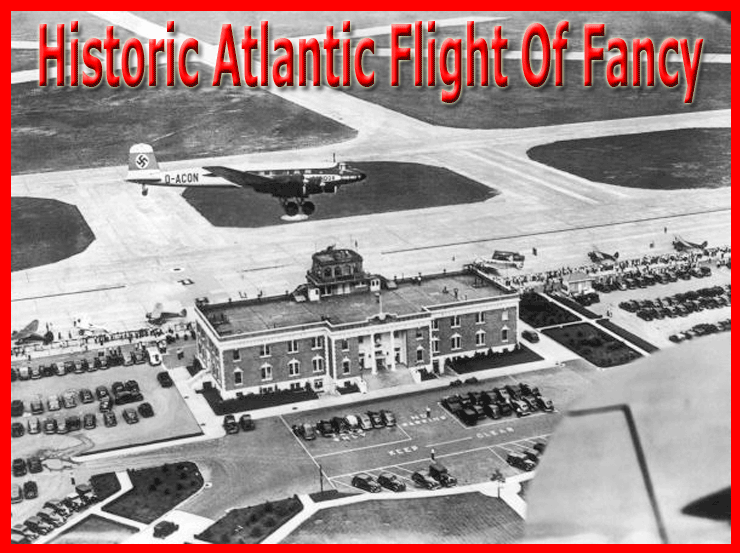
 ast
weekend marked the 75th anniversary of the first non-stop transatlantic
flight of a land-based passenger aircraft to New York. ast
weekend marked the 75th anniversary of the first non-stop transatlantic
flight of a land-based passenger aircraft to New York.
Landing at Floyd Bennett Field in New
York City on August 11, 1938, just before 16:00 hours local time, a
German built four-engine Focke-Wulf VI 200 “Condor,” registered
D-ACON & christened “Brandenburg,” arrived from Berlin
having flown 4,100 miles (6,000 kilometers) non-stop across the Atlantic
in 24 hours and 57 minutes, at an average speed of 164 MPH (263kmh/h).
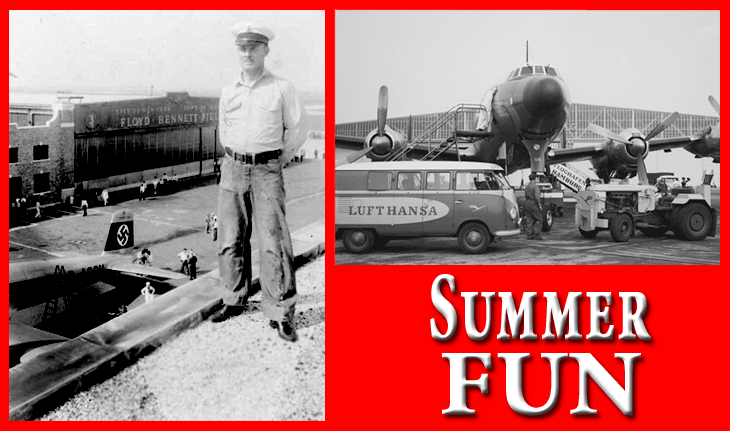 |

The "experimental" flight caused
a sensation, sent shock waves around the world, and scared the hell
out of Pan American Airways, which had already established the first
commercial air service to Europe utilizing a puddle-jumping flying boat,
the Sikorsky S42 aircraft.
The first Pan Am flights went from Port
Washington, New York, to England via Shediac, New Burnswick, and Botwood,
into Foynes, Ireland, and onto Southhampton.
In winter those flights operated across
a southern route from Norfolk, Virginia, to Europe via Bermuda, and
the Azores into Lisbon where they landed on the Tagus River.
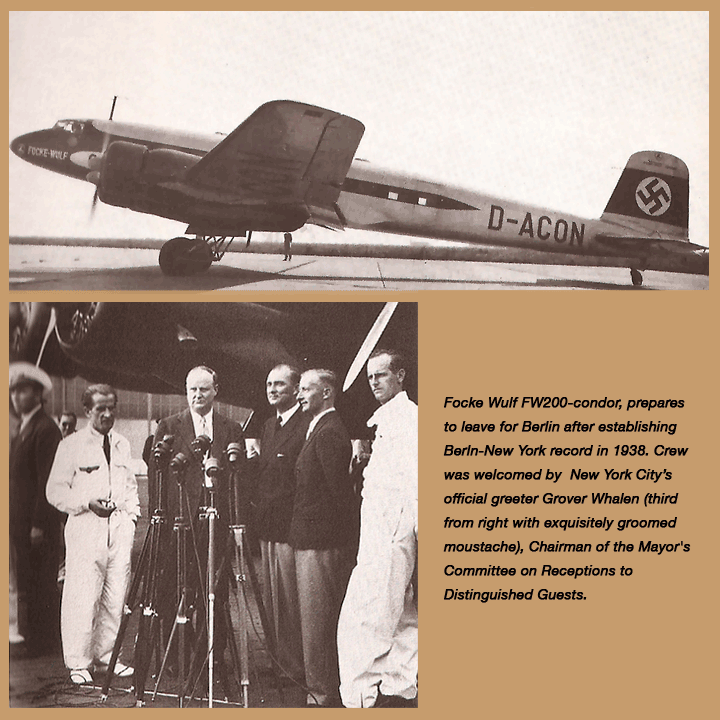 |

But by 1938 Pan Am had bet the airline
on a dozen 100-ton flying boats from Boeing—B314s, which it planned
to launch from Port Washington to Europe in 1939, and then move over
to LaGuardia Airport in New York City in 1940.
The B314 carried more people (46 vs. 23)
and was a sound-deadened, luxurious first class ride, but it was a giant
lumbering vehicle that operated low and slow compared to the FW200.
It’s not unfair to say that the FW200 was like the 1938 version
of the fast-moving Concorde, whereas the B314 was like every other slow-go
aircraft cruising the skies.
Of course, WW II ended the high adventure
and further development of commercial air services, and by 1945 Lufthansa
was out of business altogether.
But during the conflict, both aircraft
served with the B314s as the only long-range aircraft in the USA arsenal
at onset, and the Focke-Wulfs served in various transport and other
wartime duties in Germany.

We will never know how the rivalry between
B314 and FW200 might have panned out, although just imagining the possibilities
75 year later is delicious.
The order book for FW 200s was building
at the dawn of trans-Atlantic flight.
For example, Finnair ordered the FW200
as early as 1941, anticipating services to New York from Helsinki.
To generate interest, handmade display
models of the first AY aircraft were actually part of the Finland Pavilion
at the 1939 World’s Fair held in Flushing Meadow, just near LaGuardia
Airport in New York City.
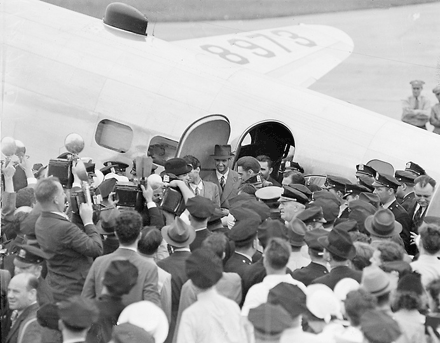 For its part, Germany had withdrawn from
the World’s Fair in 1939 after Poland, and with the war looming
any effort to further market and sell FW200s on the international stage
was lost forever.
For its part, Germany had withdrawn from
the World’s Fair in 1939 after Poland, and with the war looming
any effort to further market and sell FW200s on the international stage
was lost forever.
But undoubtedly the FW 200 and its later,
more developed versions would have booked orders from U.S. carriers
including rival TWA, if not Pan Am itself.

TWA would have been an especially intriguing
customer for the FW200 as the carrier was still five years away from
owner Howard Hughes’ move to operate the Lockheed Constellation.
It’s worth noting that less than
one month before the Brandenburg’s arrival at Floyd Bennett, on
July 14, 1938, Howard Hughes landed at the field after flying his Lockheed
14 around the world, setting a speed record for that journey of 3 days,
19 hours, and 17 minutes.

How the 1939 World’s Fair (in reality,
a mega tradeshow) scenario might have impacted not only Pan Am but also
the developing airline business can only be imagined, particularly while
watching another Airbus A380 take off.

After its historic flight to New York
City, which included a grand ride for the crew all the way down Flatbush
Avenue through Brooklyn to Manhattan, the return flight of Brandenburg
to Germany on August 13, 1938, took 19 hours and 47 minutes at an average
speed of 205 MPH (330 km/h), riding the ever-sweet tailwind from New
York.
Later in November, Brandenburg flew from
Berlin to Basra, Karachi, Hanoi, and Tokyo in only 46 hours and 18 minutes,
but on the return flight D-ACON ran out of fuel and ditched in the ocean
near Manila.
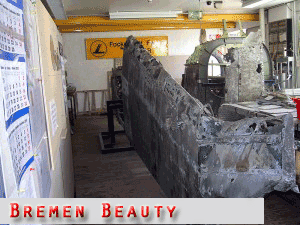 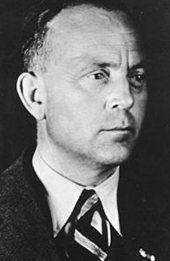
The 26-passenger Condor was designed,
under the leadership of Kurt Tank, (right) technical director of Focke-Wulf
Flugzeugbau of Bremen, and the prototype made its first flight on July
27, 1937.
Alas, today there are no FW200s left in
the world, although the remains of one was discovered in 1981 in a Norwegian
fjord near Trondheim and was taken to Germany by aviation enthusiasts
who reportedly continue to raise funds and work to bring back an airplane
that will never fly again.

There is only so much money to go around
for these things, so the restoration for the rescued Norwegian FW200
may have been slowed down by Lufthansa’s zeal to restore a flyable
Lockheed Constellation (L-1649A), taking place right now at Lufthansa
Technik; the airplane that brought the carrier back to New York in 1958
expects to be airborne in 2014.
After the L-1649As were retired in favor of
jets, in 1960 Lufthansa converted two of the Super Stars to cargo aircraft.
As Lufthansa's first long-range cargo
aircraft, they continued to fly between Germany and the USA.
In those years of the "economic miracle,"
their cargo capacity helped to lay the foundation for Germany's present
day role as a leading export nation.
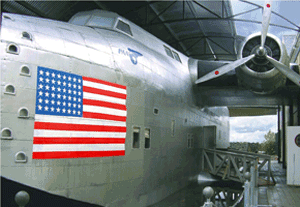 
The only B314 experience left in the world is at Foynes, Ireland, where
the Irish National Air Museum has lovingly and faithfully recreated
a section and interior details of “The Yankee Clipper,”
attached to the museum’s main building.
On August 11, Lufthansa, one of the greatest
if not most respected airlines in the world, handed out postcards on
their Germany to USA flights detailing the exploits of The Brandenburg
75 years ago, on the date of its epoch and historic flight of fancy.
Geoffrey/Flossie
|








 For its part, Germany had withdrawn from
the World’s Fair in 1939 after Poland, and with the war looming
any effort to further market and sell FW200s on the international stage
was lost forever.
For its part, Germany had withdrawn from
the World’s Fair in 1939 after Poland, and with the war looming
any effort to further market and sell FW200s on the international stage
was lost forever.

